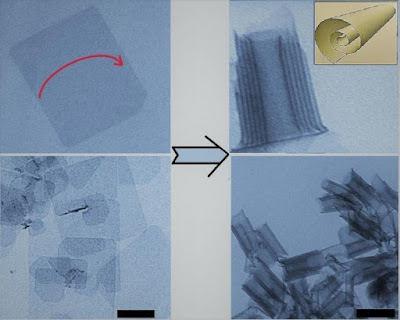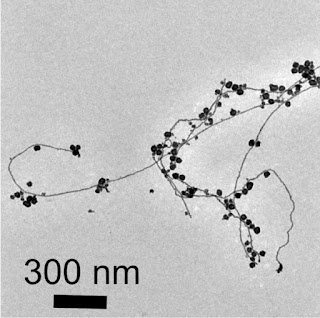Two-Dimensional Cadmium Telluride Naturally Folds into Nanoscrolls
"We examined 2D cadmium telluride CdTe and found a surprising impact of unconstrained collapsing of its ultrathin (just 1 nm) sheets that are additionally called colloidal quantum wells," said Roman Vasiliev, a co-creator of the examination, PhD of Chemical Sciences, and Associate Professor of the Faculty of Chemistry and the Faculty of Materials Science, MSU.
Full Story:
Colloidal quantum wells are the most recent age of colloidal quantum specks. Quantum spots are perceived by their luminescent properties and are utilized as a part of business contraptions, for example, TV sets. Quantum wells, a 2D sort of quantum dabs, are being investigated today, however they have extremely limit radiance groups, which is indispensable for splendid shading rendering in light-radiating gadgets.
Colloidal quantum wells are the most recent age of colloidal quantum specks. Quantum spots are perceived by their luminescent properties and are utilized as a part of business contraptions, for example, TV sets. Quantum wells, a 2D sort of quantum dabs, are being investigated today, however they have extremely limit radiance groups, which is indispensable for splendid shading rendering in light-radiating gadgets.
The group analyzed the properties of 2D sheets of cadmium telluride by trading natural particles appended to their surface and bracing the strength of nanoparticles. In order to incorporate 2D cadmium telluride, the group utilized the colloidal system and acquired them in a jar. To do as such, the specialists began a response of getting cadmium telluride nanoparticles from a natural dissolvable within the sight of surfactants. By modifying the states of the response they made the particles to develop into one nanometer thick sheets.To do as such, the scientists began a response of getting cadmium telluride nanoparticles from a natural dissolvable within the sight of surfactants. By modifying the states of the response they made the particles to develop into one nanometer thick sheets.
At first, the analysts developed level 2D sheets secured with oleic corrosive as a stabilizer. They figured out how to get sheets with length achieving many nanometers and thickness of precisely one nanometer. From that point forward, the group started substituting the atoms of oleic corrosive with other natural particles and looking at shapes and sizes of the gained nanoparticles, and also their creation and precious stone structure. At this stage, they made utilization of a transmission electron magnifying lens from the MSU Shared Knowledge Center.
Amid the examination, the group discovered that when a specific sort of stabilizers (thiols) is utilized, level sheets of cadmium telluride startlingly overlap into consummate parchments. At the point when connected to the surface of a sheet, thiol atoms develop in thickness by one monolayer (0.15 nm) and cause mechanical burdens making the sheet to overlap in a particular crystallographic course. The collapsing occurs for all nanoparticles at the same time, and the range of the overlay is indistinguishable for all nanostructures.
Related Conference:
"20th International Conference on Advanced Materials Science and Nanotechnology"
Venue: Dubai, UAE
Date: 27-28, 2018
Submit your research papers at:
https://materialscience-nano.conferenceseries.com/abstract-submission.php
Related Conference:
"20th International Conference on Advanced Materials Science and Nanotechnology"
Venue: Dubai, UAE
Date: 27-28, 2018
Submit your research papers at:
https://materialscience-nano.conferenceseries.com/abstract-submission.php





Comments
Post a Comment